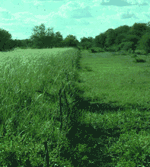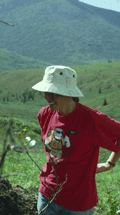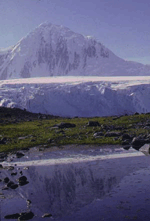Although use of the term ‘stress’ has been controversial in ecology, when defined as levels of any factor that reduce plant performance, this operational definition can be used. Several of my diverse research projects over the past two decades fall under this general heading.
A series of studies examined variation in the response of oak trees to gypsy moth defoliation, a local factor that has only recently impacted area forests as this exotic pest has dispersed south and west from its point of introduction. Effects of other herbivores associated with human population pressure, namely cattle, have been studied in Zimbabwe wetlands called dambos. Another set of studies dealt with acid mine drainage and its effects on wetland plants. A third theme for these studies has been the role of competition from other plants, usually with respect to a particular limiting resource such as space, water, nitrogen, or light.
| Fence dividing a dambo wetland into grazed (right) and ungrazed (left) areas. The property on the right is communally owned land in Zimbabwe while on the left is a commercial farm, in which cultivation of dambos is prohibited by law. |  |
Many of our studies of stress have emphasized the selective importance of various aspects of the abiotic and biotic environment. My Ph.D. students have worked especially hard in a series of field studies showing how natural selection becomes involved in the stress response. Cynthia Bennington, my first Ph.D. student, studied genetic differentiation of an annual plant, Impatiens pallida, across a complex drought gradient in W.V.U.’s Core Arboretum. Her study was a superb demonstration of the application of modern ecological genetic approaches to the study of natural selection. In a Herculean reciprocal transplant study, she showed that both heritability of traits and natural selection on those traits was environment-dependent, providing direct evidence for the causes of differentiation between adjacent populations. Milan Vavrek, my second Ph.D. student, used the unique breeding system of dandelions to examine genetic differentiation with respect to season within a single field. Using a massive cloning experiment, he examined how and why selection changes across seasons, helping to maintain genetic variation in a species that has no mechanism for regenerating it (i.e., no recombination) every generation. My third Ph.D. student, Jill Cooke, studied how UV-B radiation environments produce an altered selection environment for plants in both a model system (Arabidopsis thaliana) and in an Antarctic plant (Colobanthus quitenses) that is experiencing the ozone hole annually. Her important experimental work showed that the destruction of the ozone hole through release of CFC’s by humans can result in potential evolutionary shifts thousands of miles away in an Antarctic plant population.
| Graduate student Cindy Bennington helped lead Earthwatch expeditions to Alaska while doing research for her M.S. She later completed her Ph.D. work in West Virginia. She then took a postdoctoral position at Princeton University, followed by a tenure-track job at Stetson University in Florida |  |
| NSF funded research on UV-B radiation effects on plants led to two separate expeditions to Antarctica by the McGraw lab. While there, source plant material for seed bank and flavonoid variation studies were collected for experiments performed at W.V.U. |  |